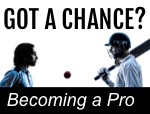|

Imagine what your perfect cricketing day would be like.
From the moment you wake to the time you close your eyes to sleep, everything goes completely to plan. What would it look like?
It's an exercise that not only feels good but has practical applications.
You are using what Tim Ferris calls 'dreamlining': the art of goal setting to reach your dreams. Research has shown that good goal setting dramatically increases your chances of achieving sporting success.
And that starts with imagining your perfect day.
Think about the house you live in, the types of decor, the food you eat, what you drink, the clothes you wear, the car you drive, how you prepare for the match, the type of game you have against what kind of opposition and what happens after play? In short, every tiny detail.
Write it all down somewhere you can refer back to it.
Psychologist James Hamilton has used this method too. Ferris makes the dream include all the things you want to do no matter how unusual or one off they are. James builds on this technique by making the day as regular as possible.
It's worth the effort
Most people can quickly come up with a list of hopes and dreams quite quickly but many still feel daunted by the task. They put it off. The dreams stay as dreams.
It's easy to understand: Goal setting is about putting your life down on paper.
What if you miss something out?
What if you change your mind? What if you fail in reaching those goals?
What if others consider your dreams as silly or impossible?
What if you can't afford it?
What if something stops you?
That's a lot of worries. It's no wonder people don't bother with goal setting. You can do it you take these principles on board:
- Failure is essential. The route to success is not a smooth path. It's a winding road with ups and downs along the way. You will fail at times. You will lose track and let yourself and others down. Allowing yourself to fail in pursuit of your goal is important because, as James Hamilton says, that this is what humans do, even successful ones.
- Action trumps inaction. Goal setting is partly about finding out what real life actions you need to take to achieve. Research into successful businessmen has shown they all are driven by taking action on their plans, even if it is the wrong action. It's more important to be doing something than nothing, to be moving forward than frozen by fear of failure.
- There is never the perfect time to start. It's natural to imagine that the perfect plan needs the perfect start. In fact, the opposite is true. It's essential to start when conditions are not right because conditions are never right. There will be times when things are easier, but you can never know when this will be.
- You can change your mind. If you do start and things go wrong, you can start again any time you like. You can even drop the entire goal and change to something else if you want. It's hard to identify what you really want and you might make a mistake. Accept that will happen and start again, or start something else. You can always come back another time.
- Life is not perfect. In real life, even your perfect day will include plenty of annoyances. You can't control traffic jams, other people's behaviour or stuff breaking which will always happen, sometimes at exactly the wrong moment. It's not a sign of failure; it's something everyone goes through. A goal is only worthwhile if it is worth having in spite of these things.
- Your success is your responsibility. Despite all the previous caveats, one thing still remains true: It's your responsibility to reach your goals. You will mess up, get it wrong, face negative people and suffer roadblocks but you still need to act. It's easy to fall into the trap of blaming others. As consultant Brain Tracy says, focus on what you can do now.
SO take that time and start the glorious mess that is planning.
What next?
When you have your perfect day on paper, what happens next?
You need to find out what the practical steps are to making your dreams a reality, and there is a simple process to doing this.
James Hamilton suggests starting by taking a look at your day and sorting out each goal into the following:
- Have now, or can get now.
- Able to achieve or get if you put your mind to it.
- Able to achieve or get with a lot of planning and application.
- Requires a change in the behaviour or attitudes of other people or is impossible.
The first two categories can be the hardest to identify. We tend to assume that our ideal day will be utterly unlike what we do now. We tend to rule out the things that satisfy us now as having any part in some kind of glowing future.
For example, if you want to become a more accurate bowler all you need is get down the nets and start tracking. You can get close to your ideal without huge effort once you learn how to identify what parts of your perfect day fit into those first two categories.
Category three is more like Tim Ferris' dreamlining: The big stuff like travel and career aims taking months or years to achieve. You might be looking to make it as a professional cricketer, or take more wickets in the league than anyone else.
Category four is trickier. Be careful of anything that is dependent on the attitudes and behaviours of other people.
You are not fully in control of how your family, friends, team mates, coaches or colleagues treat you. All you are in control of is how you treat yourself. Any goal you have that needs you to hold other people’s strings is impossible for you to achieve alone.
Time to get things done
Having removed anything you can't control, it's time to get everything else done. This is where the dreaming stops and you start to outline the real, practical and simple steps.
Far and away the best way of doing this can be found in a book called 'Getting Things Done' (GTD) by Management Consultant David Allen.
It's a well tried and proven system in the business world to improve productivity, but it can work just as well for you to make yourself better at cricket. A task is still a task if it is 'go to nets' or 'attend meeting'.
The strength of GTD is that it gives you a place to hold all the practical actions that is not in your brain. Trying to remember everything is bound to failure. How often, for example, do you remember to buy toilet roll when you are standing in the toilet roll aisle in the supermarket?
As Allen say, we are great at having ideas but awful at holding them in our brains. So use a system instead.
So pick up your perfect day listed in categories, grab a fresh sheet of paper and do the following:
- Start with anything that take one simple step (make a phone call, look at a website, cook breakfast) and can be done right now. Do it immediately.
- Then take anything that is left that take one simple, clear next action (buy bat, go to nets) and put it in a list. If it's a time based action (like a meeting or a game) put it in some kind of calendar to remind you when it is. If you could do it any time write it on a list called "Next Actions". If you have more than 20 or so next actions you will probably want to subdivide the list into contexts like "Calls" for phone calls you need to make or "Errands" for shopping you need to do (put "buy toilet roll" on the errands list and refer to it when you are in the supermarket).
- You should be left with the things that will take a few more steps to complete. Allen calls these Projects. An example of a small project would be "Get car fixed" as above. A bigger, longer project might be to cement a place in the First XI. As a general rule, these projects should not take longer than a year to complete.
- From this list of projects you now need to identify the next physical action for each one. Add these actions to your Next Action list or calendar from before. If you have more than 20 next actions, subdivide them by context again.
- You may find at this point there are some actions you have that rely on someone else to do something. If so, create a list called "Waiting For" and put all those actions in that list.
- There may be some things you would like to do one day but don't want to commit to starting just yet. Put these in a list called "Someday/Maybe" and forget about them for now (you can always check back on that list later).
Now you should be armed with the following:
- A calendar with time based items on it
- A list of projects
- A list of next actions (sorted by context if necessary)
You can now start completing those actions and projects, safe in the knowledge you are moving, action by action, towards your perfect day goals.
The GTD system is a bit more involved that what I have outlined here. If you are serious about reaching your goals in cricket (or in work, or the rest of life) I strongly suggest you buy the book. For a quick overview of GTD in general, click here.
This may seem like a lot of effort for often distant reward. That's because it is. But good planning combined with flexible execution of those plans will make your chances of becoming a cricketer all the better.
Let us know how you go.
Discuss this article with other subscribers
|

.jpg)
.jpg)


.jpg)
.jpg)
